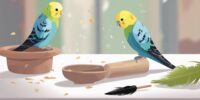When to Opt for a Pacific Parrotlet as a Pet
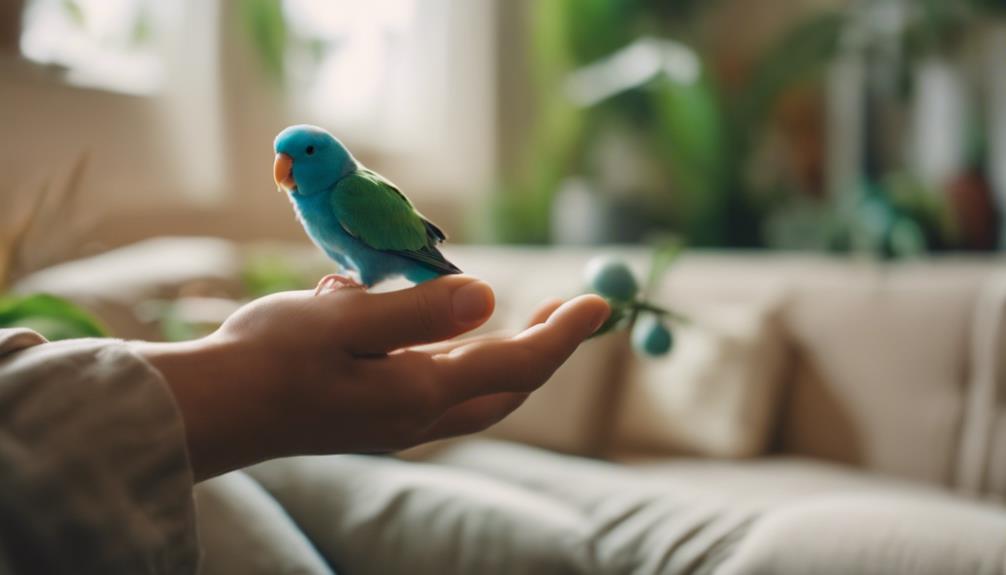
If you are considering getting a Pacific Parrotlet as a pet, it is important to understand their care needs and personality traits before making a decision.
These small parrots are known for their bold and curious nature, making them entertaining pets to have around. They require a spacious cage with plenty of toys and stimulation to keep them happy and healthy.
Pacific Parrotlets also need a diet rich in fresh fruits and vegetables, along with a high-quality pellet mix. Regular interaction and socialization are crucial for their mental well-being, as they are social creatures that thrive on companionship.
Before bringing a Pacific Parrotlet into your home, be sure to do thorough research and consider if you have the time and resources to provide for their needs. With proper care and attention, these charming birds can make wonderful companions for the right owner.
Size and Space Requirements
When considering a Pacific Parrotlet as a pet, it's essential to understand their size and space requirements to provide a suitable environment for their well-being. These vibrant birds require a cage size of at least 18x18x18 inches to allow ample room for movement and exercise. Additionally, it's crucial to provide a variety of toys within the cage to stimulate their mental and physical well-being.
In terms of room layout, it's recommended to place the cage in an area that allows for natural light exposure without direct sunlight. This will help maintain their circadian rhythm and overall health. Furthermore, Pacific Parrotlets benefit greatly from regular flight time outside of their cage. Allowing them this freedom helps prevent boredom and encourages natural behaviors.
Social and Interactive Nature
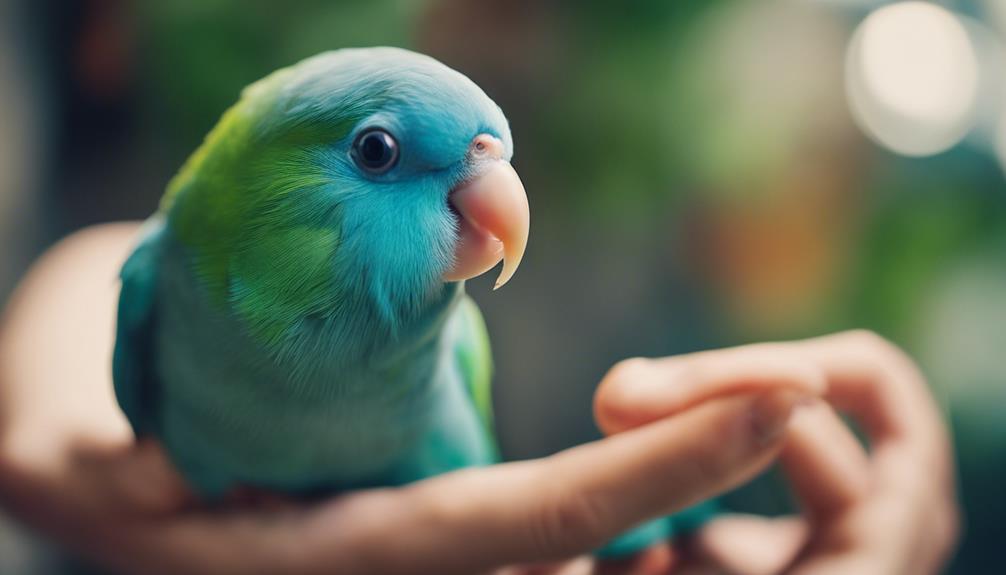
Pacific Parrotlets are known for their playful and affectionate nature, often forming strong bonds with their human companions. These tiny birds enjoy interacting with people and can be quite social, thriving on attention and interaction.
Their charming personalities make them delightful companions for those looking for a small but engaging pet bird.
Playful and Affectionate
Known for their playful and affectionate demeanor, Pacific Parrotlets are social birds that thrive on interactive engagement with their human companions. These vibrant birds enjoy playtime activities and bonding exercises with their owners. Incorporating training techniques and being attentive to their behavioral cues can further enhance the relationship between pet and owner.
Parrotlets are known to be curious and intelligent, making them receptive to learning new tricks and commands. Engaging in interactive play sessions, such as teaching them to fetch or solving puzzles together, can strengthen the bond between the bird and its human family. Providing mental stimulation and affectionate interactions are essential for ensuring the well-being and happiness of these charming feathered companions.
Bonding With Humans
With their social and interactive nature, Pacific Parrotlets form strong bonds with their human companions through engaging interactions and playful activities. To foster a deep connection, employing training techniques such as positive reinforcement and consistency can help establish trust and strengthen the bond.
Socialization strategies, like providing diverse enrichment activities and spending quality time together, are crucial for the parrotlet to feel comfortable and secure in its human relationship. Understanding communication cues, such as body language and vocalizations, is essential for effective interaction and building a mutual understanding.
Noise Level and Vocalizations
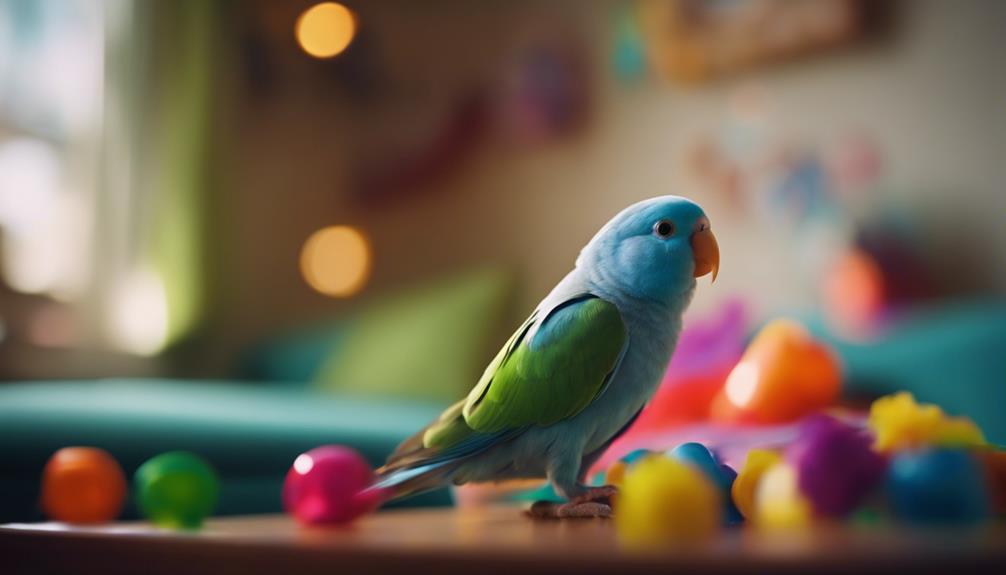
When considering a Pacific Parrotlet as a pet, potential owners should be aware of its noise level and vocalization tendencies. Pacific Parrotlets are known for their high-pitched, chirpy vocalizations that can be quite loud for their small size. While they aren't as noisy as some other parrot species, they still have the capacity to produce consistent chatter throughout the day. To address excessive vocalization, training techniques and behavior modification can be employed. Positive reinforcement for quiet behavior and ignoring or redirecting loud vocalizations can help in managing their noise levels.
Understanding the communication cues and body language of Pacific Parrotlets is crucial in deciphering the reasons behind their vocalizations. These birds may vocalize to seek attention, express emotions like excitement or distress, or simply to communicate with their human companions. By observing their body language and vocal patterns, owners can better interpret their needs and respond accordingly. Providing mental stimulation, social interaction, and a consistent routine can also help in keeping Pacific Parrotlets content and less likely to engage in excessive vocalizations.
Feeding and Diet Considerations
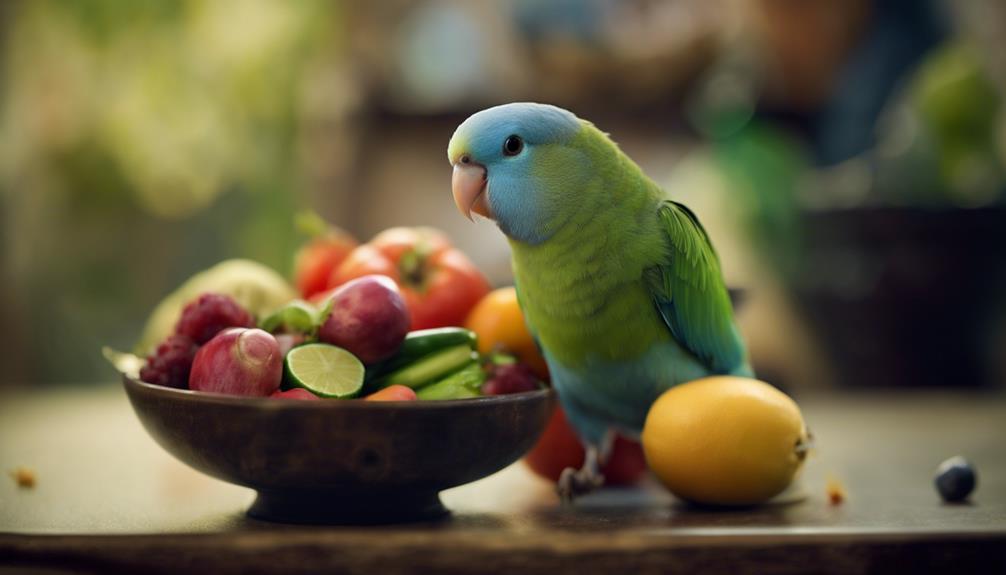
For optimal health and well-being, Pacific Parrotlets require a balanced and varied diet that consists of high-quality pellets, fresh fruits, and vegetables. Ensuring nutritional balance is crucial for these vibrant birds.
Here are some essential considerations for feeding and diet:
- Nutritional Balance: Provide a mix of pellets, fresh fruits, and vegetables to meet all their dietary needs.
- Feeding Schedule: Establish a consistent feeding routine to regulate their intake and avoid overeating.
- Fresh Produce: Include a variety of fresh fruits and vegetables to offer essential vitamins and minerals.
- Seed Mix Ratios: Limit seed intake and use it as a treat, focusing on a more balanced diet of pellets and fresh foods.
- Consult a Avian Veterinarian: Seek guidance from a professional to tailor the diet to your Pacific Parrotlet's specific needs.
Exercise and Enrichment Needs
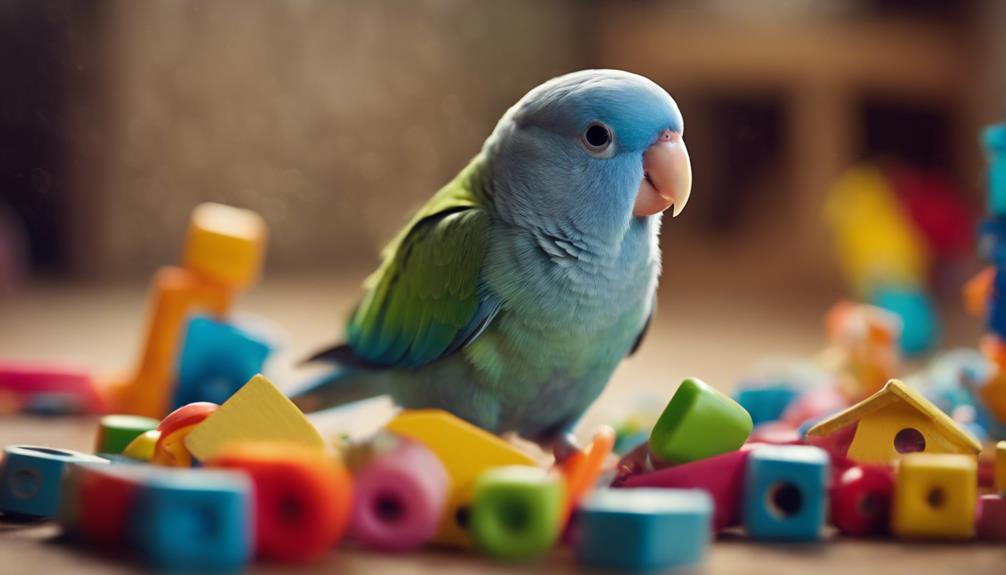
To ensure the optimal health and well-being of Pacific Parrotlets, it is essential to address their exercise and enrichment needs through engaging activities and stimulating environments. These intelligent and active birds require mental stimulation and playtime to thrive. Providing a variety of enrichment activities is crucial in preventing boredom and related behavioral issues. Here are some key ways to keep your Pacific Parrotlet happy and healthy:
| Enrichment Activities | Description | Benefits |
|---|---|---|
| Foraging Toys | Hide treats for them to find | Mental stimulation, natural behavior |
| Puzzle Feeders | Food-dispensing puzzles | Encourages problem-solving skills |
| Training Sessions | Teach tricks and commands | Builds trust, mental engagement |
| Rotating Toys | Introduce new toys regularly | Prevents boredom, maintains interest |
Engaging with your Pacific Parrotlet through these activities not only provides physical exercise but also promotes their cognitive abilities and overall well-being. Remember, a stimulated parrotlet is a happy parrotlet!
Grooming and Maintenance Tips
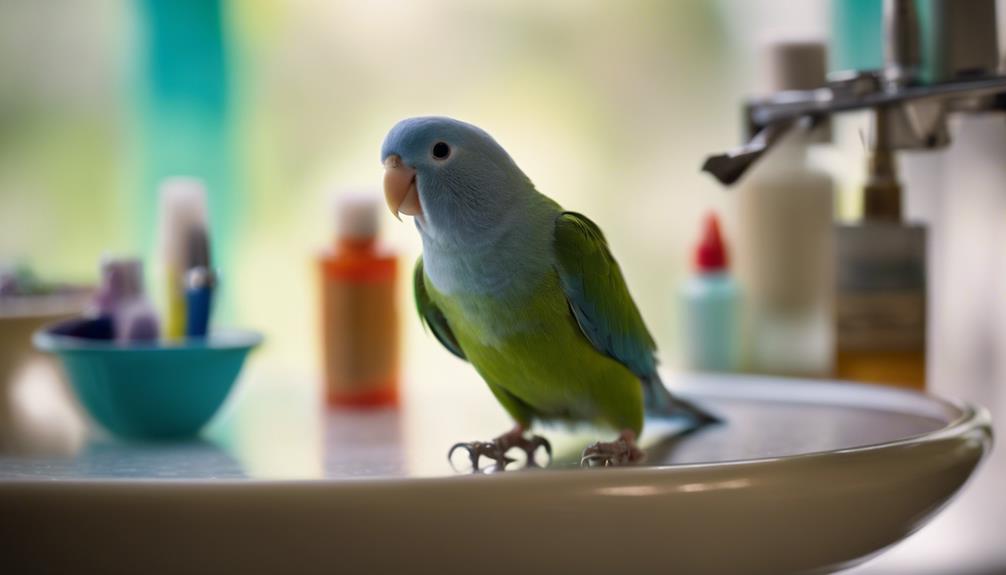
When caring for a Pacific Parrotlet, it's crucial to understand the importance of grooming and maintenance. This includes:
- Nail trimming tips to ensure their comfort and health.
- Feather care advice to maintain their plumage.
- Bathing frequency suggestions for optimal cleanliness.
Nail Trimming Tips
Keeping your Pacific Parrotlet's nails at an appropriate length is crucial for their health and comfort. Regular nail trims help prevent overgrowth, which can lead to discomfort and difficulty perching. Here are some tips to make nail trimming a positive experience for both you and your feathered friend:
- Create a Calm Environment: Ensure the room is quiet to reduce stress.
- Use Proper Tools: Invest in good-quality clippers designed for birds.
- Practice Patience: Start slow and reward your parrotlet for good behavior.
- Seek Professional Help if Unsure: Don't hesitate to consult a vet or a professional groomer.
- Monitor Nail Length Regularly: Check your parrotlet's nails frequently to maintain them at an appropriate length.
Feather Care Advice
Regular grooming and maintenance of your Pacific Parrotlet's feathers is essential for their overall health and well-being. Proper feather care plays a crucial role in preventing issues such as feather plucking and supporting a healthy molting process. Here are some feather care tips to help you ensure your parrotlet's feathers stay in optimal condition:
| Feather Care Tips | Description | Frequency |
|---|---|---|
| Regular Inspections | Check for signs of damage | Weekly |
| Healthy Diet | Balanced nutrition is essential | Daily |
| Dust Bathing | Helps maintain feather health | Bi-weekly |
Bathing Frequency Suggestions
Proper grooming and maintenance of your Pacific Parrotlet's feathers include establishing an appropriate bathing frequency to ensure their optimal health and well-being. Regular baths provide numerous health benefits for your feathered friend, such as helping to remove dust and dirt, preventing feather plucking, and promoting healthy feather growth. When bathing your Pacific Parrotlet, ensure the water temperature is lukewarm, as extreme temperatures can be harmful.
Here are some bathing frequency suggestions to keep your Pacific Parrotlet happy and healthy:
- Bathe your Pacific Parrotlet 2-3 times a week
- Monitor your bird's reaction to baths; adjust frequency as needed
- Use a shallow dish or misting bottle for bathing
- Avoid using soaps or shampoos, as they can strip essential oils
- Always provide fresh water for drinking after a bath.
Health and Lifespan Expectations
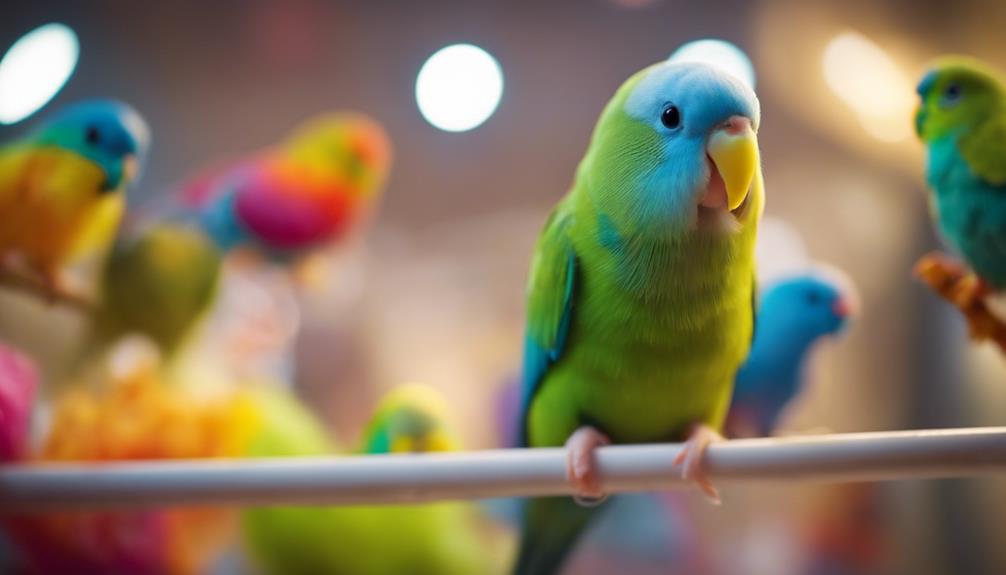
Ensuring the health and understanding the typical lifespan of a Pacific Parrotlet is crucial for responsible pet ownership.
Common health issues in Pacific Parrotlets include respiratory problems, obesity, and beak overgrowth. To prevent these issues, owners should provide a balanced diet, regular exercise, and access to fresh air. Regular veterinary check-ups are also essential to catch any health concerns early on.
Pacific Parrotlets have an average lifespan of 15-20 years when provided with proper care. Lifespan can vary depending on genetics, diet, exercise, and overall living conditions.
Proper care requirements for Pacific Parrotlets include a spacious cage, mental stimulation, social interaction, and a clean environment. Providing a well-balanced diet rich in fruits, vegetables, and high-quality pellets is crucial for their overall health and longevity.
Frequently Asked Questions
Can Pacific Parrotlets Be Trained to Talk Like Larger Parrot Species?
Pacific Parrotlets can be trained to talk like larger parrot species. Training methods focus on repetition and positive reinforcement. Challenges may include the individual bird's personality and dedication needed from the owner. Their vocal mimicry capabilities are impressive.
Do Pacific Parrotlets Require a Specific Type of Cage or Enclosure?
When considering cage requirements for Pacific Parrotlets, it's essential to provide a spacious environment with appropriate toys for mental stimulation. Proper diet and exercise are crucial for their well-being, ensuring a healthy and happy pet.
Are Pacific Parrotlets Prone to Any Specific Health Issues or Diseases?
Pacific Parrotlets may experience common illnesses like respiratory infections or feather plucking. Preventive measures include regular vet check-ups, a balanced diet, and a clean environment. Early detection and proper care are vital for their well-being.
How Often Should Pacific Parrotlets Be Taken to the Vet for Check-Ups?
Regular vet check-ups are essential for Pacific Parrotlets to monitor their health and well-being. These check-ups ensure early detection of any potential issues and allow for timely intervention. Proper diet and socialization are also crucial for their overall health.
Are Pacific Parrotlets Good Pets for Families With Young Children?
Are Pacific Parrotlets good pets for families with young children? Pacific Parrotlets can be great family pets with proper training methods. Child interaction should be supervised to ensure safety for both the bird and the child.




